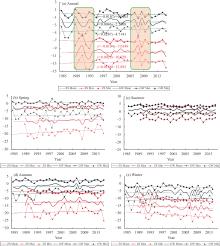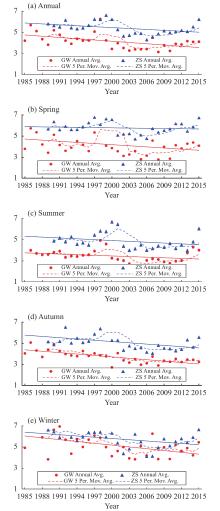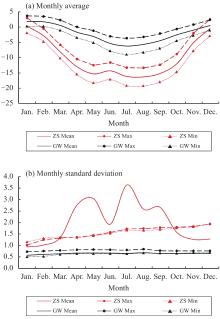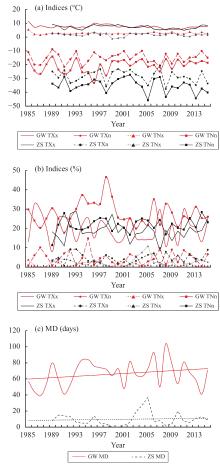Sciences in Cold and Arid Regions ›› 2018, Vol. 10 ›› Issue (5): 369–378.doi: 10.3724/SP.J.1226.2018.00369
Comparison of temperature extremes between Zhongshan Station and Great Wall Station in Antarctica
AiHong Xie1,*( ),ShiMeng Wang1,*(
),ShiMeng Wang1,*( ),YiCheng Wang1,2,ChuanJin Li1
),YiCheng Wang1,2,ChuanJin Li1
- 1 State Key Laboratory of Cryospheric Science, Northwest Institute of Eco-Environment and Resources, Chinese Academy of Sciences, Lanzhou, Gansu 730000, China
2 Gansu Meteorological Administration, Lanzhou, Gansu 730020, China
| 1 |
Allison I Surface climate of the interior of the Lambert Glacier basin, Antarctica, from automatic weather station data. Annals of Glaciology 1998; 27: 515- 520.
doi: 10.3189/1998AoG27-1-515-520 |
| 2 |
Amesbury MJ, Roland TP, Royles J, et al. Widespread Biological Response to Rapid Warming on the Antarctic Peninsula. Current Biology 2017; 27: 11 1616- 1622.
doi: 10.1016/j.cub.2017.04.034 |
| 3 |
Barbante C, Barnola JM, Becagli S, et al. One-to-one coupling of glacial climate variability in Greenland and Antarctica. Nature 2006; 444: 7116 195- 198.
doi: 10.1038/nature05301 |
| 4 | Berg H Zum begriff der kontinentalität. Meteorologische Zeitschrift 1944; 61: 283- 284. |
| 5 |
Blunier T, Brook EJ Timing of millennial-scale climate change in Antarctica and Greenland during the last glacial period. Science 2001; 291: 5501 109- 112.
doi: 10.1126/science.291.5501.109 |
| 6 |
Bromwich DH, Nicolas JP, Monaghan AJ, et al. Central West Antarctica among the most rapidly warming regions on Earth. Nature Geoscience 2013; 6: 2 139- 145.
doi: 10.1038/ngeo1671 |
| 7 |
Chapman WL, Walsh JE A synthesis of Antarctic temperatures. Journal of Climate 2007; 20: 16 4096- 4117.
doi: 10.1175/JCLI4236.1 |
| 8 |
Chylek P, Folland CK, Lesins G, et al. Twentieth century bipolar seesaw of the Arctic and Antarctic surface air temperatures. Geophysical Research Letters 2010; 37: 8 L08703.
doi: 10.1029/2010GL042793 |
| 9 |
Clem KR, Renwick JA, McGregor J Autumn cooling of Western East Antarctica linked to the tropical Pacific. Journal of Geophysical Research: Atmospheres 2018; 123: 1 89- 107.
doi: 10.1002/2017JD027435 |
| 10 |
Conrad V Usual formulas of continentality and their limits of validity. Eos, Transactions American Geophysical Union 1946; 27: 5 663- 664.
doi: 10.1029/TR027i005p00663 |
| 11 |
Dee DP, Uppala S Variational bias correction of satellite radiance data in the ERA-Interim reanalysis. Quarterly Journal of the Royal Meteorological Society 2009; 135: 644 1830- 1841.
doi: 10.1002/qj.493 |
| 12 |
Ding QH, Steig EJ, Battisti DS, et al. Winter warming in West Antarctica caused by central tropical Pacific warming. Nature Geoscience 2011; 4: 6 398- 403.
doi: 10.1038/ngeo1129 |
| 13 | Gong JX, Xie AH, Bian LG, et al. Variation of the maximum and minimum air temperatures along the traverse route from Zhongshan to Kunlun Station, East Antarctica. Journal of Glaciology and Geocryology 2015; 37: 3 604- 613. |
| 14 | Gorczyński L Sur le calcul du degré du continentalisme et son application dans la climatologie. Geografiska Annaler 1920; 2: 324- 331. |
| 15 | Han W, Xiao CD, Guo XY, et al. Variations of precipitation form at the Great Wall station and Zhongshan station, Antarctica. Climate Change Research 2018; 14: 2 120- 126. |
| 16 | IPCC, 2012. Managing the Risks of Extreme Events and Disasters to Advance Climate Change Adaptation: Special Report of the Intergovernmental Panel on Climate Change. Cambridge, UK: Cambridge University Press, pp. 1–20 |
| 17 | IPCC, 2013. Climate change 2013: the physical science basis. contribution of working group I to the fifth assessment report of the intergovernmental panel on climate change. Cambridge, UK: Cambridge University Press. |
| 18 |
Kaufman DE, Friedrichs MAM, Smith WO Jr, et al. Climate change impacts on southern Ross Sea phytoplankton composition, productivity, and export. Journal of Geophysical Research: Oceans 2017; 122: 3 2339- 2359.
doi: 10.1002/2016JC012514 |
| 19 |
Kennicutt II MC, Chown SL, Cassano JJ, et al. Polar research: six priorities for Antarctic science. Nature 2014; 512: 7512 23- 25.
doi: 10.1038/512023a |
| 20 |
Landais A, Masson-Delmotte V, Stenni B, et al. A review of the bipolar see-saw from synchronized and high resolution ice core water stable isotope records from Greenland and East Antarctica. Quaternary Science Reviews 2015; 114: 18- 32.
doi: 10.1016/j.quascirev.2015.01.031 |
| 21 |
Lee JR, Raymond B, Bracegirdle TJ, et al. Climate change drives expansion of Antarctic ice-free habitat. Nature 2017; 547: 7661 49- 54.
doi: 10.1038/nature22996 |
| 22 |
Morgan V, Delmotte M, van Ommen T, et al. Relative timing of deglacial climate events in Antarctica and Greenland. Science 2002; 297: 5588 1862- 1864.
doi: 10.1126/science.1074257 |
| 23 |
Nicolas JP, Bromwich DH New reconstruction of antarctic near-surface temperatures: multidecadal trends and reliability of global reanalyses. Journal of Climate 2014; 27: 21 8070- 8093.
doi: 10.1175/JCLI-D-13-00733.1 |
| 24 |
Oliva M, Navarro F, Hrbáček F, et al. Recent regional climate cooling on the Antarctic Peninsula and associated impacts on the cryosphere. Science of the Total Environment 2017; 580: 210- 223.
doi: 10.1016/j.scitotenv.2016.12.030 |
| 25 |
Paolo FS, Padman L, Fricker HA, et al. Response of Pacific-sector antarctic ice shelves to the El Niño/southern oscillation. Nature Geoscience 2018; 11: 2 121- 126.
doi: 10.1038/s41561-017-0033-0 |
| 26 |
Pedro JB, van Ommen TD, Rasmussen SO, et al. The last deglaciation: timing the bipolar seesaw. Climate of the Past 2011; 7: 2 671- 683.
doi: 10.5194/cp-7-671-2011 |
| 27 |
Scambos TA, Campbell GG, Pope A, et al. Ultralow surface temperatures in East Antarctica from satellite thermal infrared mapping: the coldest places on Earth. Geophysical Research Letters 2018; 45: 12 6124- 6133.
doi: 10.1029/2018GL078133 |
| 28 |
Schneider DP, Deser C, Okumura Y An assessment and interpretation of the observed warming of West Antarctica in the austral spring. Climate Dynamics 2012; 38: 1–2 323- 347.
doi: 10.1007/s00382-010-0985-x |
| 29 |
Self AE, Brooks SJ, Birks HJB, et al. The distribution and abundance of chironomids in high-latitude Eurasian lakes with respect to temperature and continentality: development and application of new chironomid-based climate-inference models in northern Russia. Quaternary Science Reviews 2011; 30: 9–10 1122- 1141.
doi: 10.1016/j.quascirev.2011.01.022 |
| 30 |
Shepherd A, Ivins ER, Geruo A, et al. A reconciled estimate of ice-sheet mass balance. Science 2012; 338: 6111 1183- 1189.
doi: 10.1126/science.1228102 |
| 31 |
Steig EJ, Schneider DP, Rutherford SD, et al. Warming of the Antarctic ice-sheet surface since the 1957 International Geophysical Year. Nature 2009; 457: 7228 459- 462.
doi: 10.1038/nature07669 |
| 32 |
Steig EJ Cooling in the antarctic. Nature 2016; 535: 7612 358- 359.
doi: 10.1038/535358a |
| 33 |
Stocker TF, Johnsen SJ A minimum thermodynamic model for the bipolar seesaw. Paleoceanography 2003; 18: 4 1087.
doi: 10.1029/2003PA000920 |
| 34 |
Thomas ER, van Wessem JM, Roberts J, et al. Regional Antarctic snow accumulation over the past 1000 years. Climate of the Past 2017; 13: 11 1491- 1513.
doi: 10.5194/cp-13-1491-2017 |
| 35 |
Turner J, Colwell SR, Marshall GJ, et al. The SCAR READER project: toward a high-quality database of mean Antarctic meteorological observations. Journal of Climate 2004; 17: 14 2890- 2898.
doi: 10.1175/1520-0442(2004)017<2890:TSRPTA>2.0.CO;2 |
| 36 |
Turner J, Colwell SR, Marshall GJ, et al. Antarctic climate change during the last 50 years. International Journal of Climatology 2005; 25: 3 279- 294.
doi: 10.1002/joc.1130 |
| 37 |
Turner J, Lu H, White I, et al. Absence of 21st century warming on Antarctic Peninsula consistent with natural variability. Nature 2016; 535: 7612 411- 415.
doi: 10.1038/nature18645 |
| 38 |
Van Wessem JM, Reijmer CH, van de Berg WJ, et al. Temperature and wind climate of the Antarctic Peninsula as simulated by a high-resolution regional atmospheric climate model. Journal of Climate 2015; 28: 18 7306- 7326.
doi: 10.1175/JCLI-D-15-0060.1 |
| 39 |
Vaughan DG, Marshall GJ, Connolley WM, et al. Recent rapid regional climate warming on the Antarctic Peninsula. Climatic Change 2003; 60: 3 243- 274.
doi: 10.1023/A:1026021217991 |
| 40 |
Wang P, Li YM, Zhang QH, et al. Three-year monitoring of atmospheric PCBs and PBDEs at the Chinese Great Wall Station, West Antarctica: levels, chiral signature, environmental behaviors and source implication. Atmospheric Environment 2017; 150: 407- 416.
doi: 10.1016/j.atmosenv.2016.11.036 |
| 41 |
Xie AH, Allison I, Xiao CD, et al. Assessment of air temperatures from different meteorological reanalyses for the East Antarctic region between Zhonshan and Dome A. Science China Earth Sciences 2014; 57: 7 1538- 1550.
doi: 10.1007/s11430-013-4684-4 |
| 42 |
Xie AH, Wang SM, Xiao CD, et al. Can temperature extremes in East Antarctica be replicated from ERA Interim reanalysis?. Arctic, Antarctic, and Alpine Research 2016; 48: 4 603- 621.
doi: 10.1657/AAAR0015-048 |
| 43 |
Yuan NM, Ding MH, Huang Y, et al. On the long-term climate memory in the surface air temperature records over Antarctica: a nonnegligible factor for trend evaluation. Journal of Climate 2015; 28: 15 5922- 5934.
doi: 10.1175/JCLI-D-14-00733.1 |
| 44 |
Zhang YH, Wang YM, Zhang MM, et al. Seasonal variations in aerosol compositions at Great Wall Station in Antarctica. Advances in Polar Science 2015; 26: 3 196- 202.
doi: 10.13679/j.advps.2015.3.00196 |
| 45 | Zhou XJ, Bian LG, Jia PQ, et al. A preliminary study on the surface thermal regime over the Great Wall Station in Antarctica. Chinese Science Bulletin 1990; 35: 19 1638- 1642. |
| No related articles found! |










